Overblowing is the manipulation of supplied air through a wind instrument that causes the sounded pitch to jump to a higher one without a fingering change or the operation of a slide. Overblowing may involve a change in the air pressure, in the point at which the air is directed, or in the resonance characteristics of the chamber formed by the mouth and throat of the player.

A resonator is a device or system that exhibits resonance or resonant behavior. That is, it naturally oscillates with greater amplitude at some frequencies, called resonant frequencies, than at other frequencies. The oscillations in a resonator can be either electromagnetic or mechanical. Resonators are used to either generate waves of specific frequencies or to select specific frequencies from a signal. Musical instruments use acoustic resonators that produce sound waves of specific tones. Another example is quartz crystals used in electronic devices such as radio transmitters and quartz watches to produce oscillations of very precise frequency.
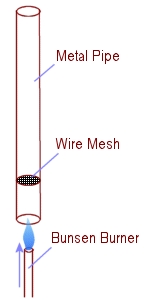
The Rijke tube is a cylindrical tube with both ends open, inside of which a heat source is placed that turns heat into sound, by creating a self-amplifying standing wave. It is an entertaining phenomenon in acoustics and is an excellent example of resonance.

An electric organ, also known as electronic organ, is an electronic keyboard instrument which was derived from the harmonium, pipe organ and theatre organ. Originally designed to imitate their sound, or orchestral sounds, it has since developed into several types of instruments:

A flue pipe is an organ pipe that produces sound through the vibration of air molecules, in the same manner as a recorder or a whistle, in a pipe organ. Air under pressure is driven through a flue and against a sharp lip called a labium, causing the column of air in the pipe to resonate at a frequency determined by the pipe length. Thus, there are no moving parts in a flue pipe. This is in contrast to reed pipes, whose sound is driven by beating reeds, as in a clarinet.
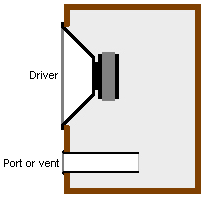
A bass reflex system is a type of loudspeaker enclosure that uses a port (hole) or vent cut into the cabinet and a section of tubing or pipe affixed to the port. This port enables the sound from the rear side of the diaphragm to increase the efficiency of the system at low frequencies as compared to a typical sealed- or closed-box loudspeaker or an infinite baffle mounting.

An organ pipe is a sound-producing element of the pipe organ that resonates at a specific pitch when pressurized air is driven through it. Each pipe is tuned to a note of the musical scale. A set of organ pipes of similar timbre comprising the complete scale is known as a rank; one or more ranks constitutes a stop.

A steam whistle is a device used to produce sound in the form of a whistle using live steam, which creates, projects, and amplifies its sound by acting as a vibrating system.

Helmholtz resonance, also known as wind throb, refers to the phenomenon of air resonance in a cavity, an effect named after the German physicist Hermann von Helmholtz. This type of resonance occurs when air is forced in and out of a cavity, causing the air inside to vibrate at a specific natural frequency. The principle is widely observable in everyday life, notably when blowing across the top of a bottle, resulting in a resonant tone.

Acoustic resonance is a phenomenon in which an acoustic system amplifies sound waves whose frequency matches one of its own natural frequencies of vibration.
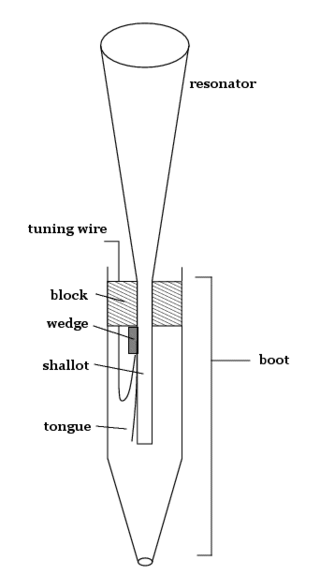
A reed pipe is an organ pipe that is sounded by a vibrating brass strip known as a reed. Air under pressure is directed towards the reed, which vibrates at a specific pitch. This is in contrast to flue pipes, which contain no moving parts and produce sound solely through the vibration of air molecules. Reed pipes are common components of pipe organs.
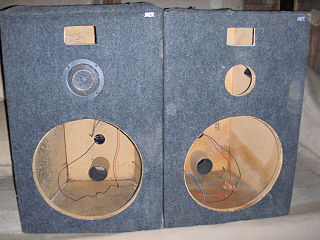
A loudspeaker enclosure or loudspeaker cabinet is an enclosure in which speaker drivers and associated electronic hardware, such as crossover circuits and, in some cases, power amplifiers, are mounted. Enclosures may range in design from simple, homemade DIY rectangular particleboard boxes to very complex, expensive computer-designed hi-fi cabinets that incorporate composite materials, internal baffles, horns, bass reflex ports and acoustic insulation. Loudspeaker enclosures range in size from small "bookshelf" speaker cabinets with 4-inch (10 cm) woofers and small tweeters designed for listening to music with a hi-fi system in a private home to huge, heavy subwoofer enclosures with multiple 18-inch (46 cm) or even 21-inch (53 cm) speakers in huge enclosures which are designed for use in stadium concert sound reinforcement systems for rock music concerts.
Whenever a wave forms through a medium/object with a closed/open end, there is a chance of error in the formation of the wave, i.e. it may not actually start from the opening of the object but instead before the opening, thus resulting on an error when studying it theoretically. Hence an end correction is sometimes required to appropriately study its properties. The end correction depends on the radius of the object.
Vocal resonance may be defined as "the process by which the basic product of phonation is enhanced in timbre and/or intensity by the air-filled cavities through which it passes on its way to the outside air." Throughout the vocal literature, various terms related to resonation are used, including: amplification, filtering, enrichment, enlargement, improvement, intensification, and prolongation. Acoustic authorities would question many of these terms from a strictly scientific perspective. However, the main point to be drawn from these terms by a singer or speaker is that the result of resonation is to make a better sound, or at least suitable to a certain esthetical and practical domain.

An electrodynamic speaker driver, often called simply a speaker driver when the type is implicit, is an individual transducer that converts an electrical audio signal to sound waves. While the term is sometimes used interchangeably with the term speaker (loudspeaker), it is usually applied to specialized transducers which reproduce only a portion of the audible frequency range. For high fidelity reproduction of sound, multiple loudspeakers are often mounted in the same enclosure, each reproducing a different part of the audible frequency range. In this case the individual speakers are referred to as drivers and the entire unit is called a loudspeaker. Drivers made for reproducing high audio frequencies are called tweeters, those for middle frequencies are called mid-range drivers, and those for low frequencies are called woofers, while those for very low bass range are subwoofers. Less common types of drivers are supertweeters and rotary woofers.

A wind instrument is a musical instrument that contains some type of resonator in which a column of air is set into vibration by the player blowing into a mouthpiece set at or near the end of the resonator. The pitch of the vibration is determined by the length of the tube and by manual modifications of the effective length of the vibrating column of air. In the case of some wind instruments, sound is produced by blowing through a reed; others require buzzing into a metal mouthpiece, while yet others require the player to blow into a hole at an edge, which splits the air column and creates the sound.
The whirly tube, corrugaphone, or bloogle resonator, also sold as Free-Ka in the 1960s-1970s, is an experimental musical instrument which consists of a corrugated (ribbed) plastic tube or hose, open at both ends and possibly wider at one end (bell), the thinner of which is rotated in a circle to play. It may be a few feet long and about a few inches wide. The faster the toy is swung, the higher the pitch of the note it produces, and it produces discrete notes roughly belonging to the harmonic series, like a valveless brass instrument generates different modes of vibration. However, the first and the second modes, corresponding to the fundamental and the second harmonics, are reported as being difficult to excite. To be played in concert the length of the tube must be trimmed to tune it.
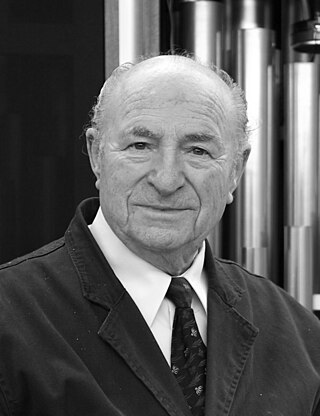
Ewald Kienle was a German inventor and entrepreneur. He developed and produced electronic church organs.

A vessel flute is a type of flute with a body which acts as a Helmholtz resonator. The body is vessel-shaped, not tube- or cone-shaped; that is, the far end is closed.
A whistle is a device that makes sound from air blown from one end forced through a small opening at the opposite end. They are shaped in a way that allows air to oscillate inside of a chamber in an unstable way. The physical theory of the sound-making process is an example of the application of fluid dynamics or hydrodynamics and aerodynamics. The principles relevant to whistle operation also have applications in other areas, such as fluid flow measurement.














